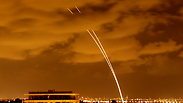
Where is the deterrence we were promised?
Op-ed: Hamas entered Gaza war as a rejected and crushed organization, and is ending it as a legitimate organization and a partner for negotiations.
Israel is the country of "170,000 missiles," according to the intelligence chiefs' definition. In other words, about 170,000 missiles are constantly directed at a small area. Even if we reduce several thousand which have been subtracted during Operation Protective Edge, the absolute majority and all the heavy ones still threaten us.
The lives of the Gaza vicinity residents are not more dangerous than the lives of the residents of Haifa, Netanya, one-floor houses in the Sharon region, the Yoo complex and Akirov concept in Tel Aviv and multi-story buildings in the Tel Aviv metropolitan area.
Hezbollah leader Hassan Nasrallah doesn't need a cause for celebration or tunnels – he is driven by a fascist Shiite perception and is in possession of tens of thousands of heavy and long-range missiles, not improvised explosive-free rockets assembled in a welding workshop in the northern Gaza Strip town of Beit Hanoun.
The politicians who flattered the public and praised it for its stamina and exemplary civil discipline, were in fact covering up and pulling the public's leg. Operation Protective Edge is nothing compared to what is expected, God forbid, in case of a war with Hezbollah.
If we go back about two years and one operation, we reach Pillar of Defense. If we go back about six years and two operations, we reach Cast Lead. If we take the goals of Cast Lead, Pillar of Defense and Protective Edge and put them side by side – we get three sisters.
The goal of the war, as defined in these operations, is remarkably identical. In all three it was defined as dealing Hamas and the terror organizations a serious blow in order to bring about a durable better security-related reality, while strengthening the deterrence.
"Deterrence" is not an operational, practical concept, but a delicate headline, which is open to interpretation. Its operational implementation can be achieved, according to the government and army, in one of the following ways or in all of them together: Killing leaders, destroying buildings and infrastructure, entering the heart of Gaza and destroying Hamas.
In the recent operation, the army failed to target the organization's senior members. They deceived the security forces and arranged an iron ground for themselves below Gaza. Going deep into the territory was never really on the agenda, for fear of an operational and diplomatic entanglement, and so the IDF was basically left with destroying building and infrastructures, which entails civilian casualties.
The empty home of Hamas leader Ismail Haniyeh, for example, was only attacked by the Air Force on the 23rd day of fighting. If that was a target, why wasn't it attacked to begin with? And if it wasn't, did the strike reflect frustration?
The statement repeated by politicians and military officials was that "when they come out of the tunnels, they'll be shocked by the destruction across the Strip." In the world, the price of this statement is very high. We are already paying for it, and we are set to pay more. Nonetheless, there is no proof that the Hamas leaders are impressed by the destruction of buildings or care about it. Nor do they care about civilian deaths.
The third Gaza war was a defensive war. It was launched by Hamas. Israel contained the rocket fire. It then retaliated only from the air. Later on, it gladly accepted a ceasefire while abandoning the tunnels invading its territory.
Hamas entered the war as a rejected and crushed organization, and is ending it as a legitimate organization and a partner for negotiations. Israel may receive calm. Hamas will receive components fitting a comprehensive deal. This issue is worth examining: How did it happen, was the war avoidable, did we think before we acted?
The political and media discourse is already engaging in the appointment of a commission of inquiry in its familiar and common sense. Commissions of inquiry benefit lawyers and journalists and provide work only for them.
The Winograd Commission, which was established after the Second Lebanon War, was known for the term "foot-dragging." It was followed by a team headed by late IDF chief of staff Amnon Lipkin-Shahak, which was appointed to implement the Winograd Commission Report, followed by a ministerial committee established to implement the Lipkin-Shahak team's report.
What came out of all of this? The same thing that came out of dozens of commissions in different areas in the state's decades of existence. If you'll allow me to paraphrase a well-known saying, policy should be changed, not probed.
Amnon Abramovich is a Channel 2 News commentator.










